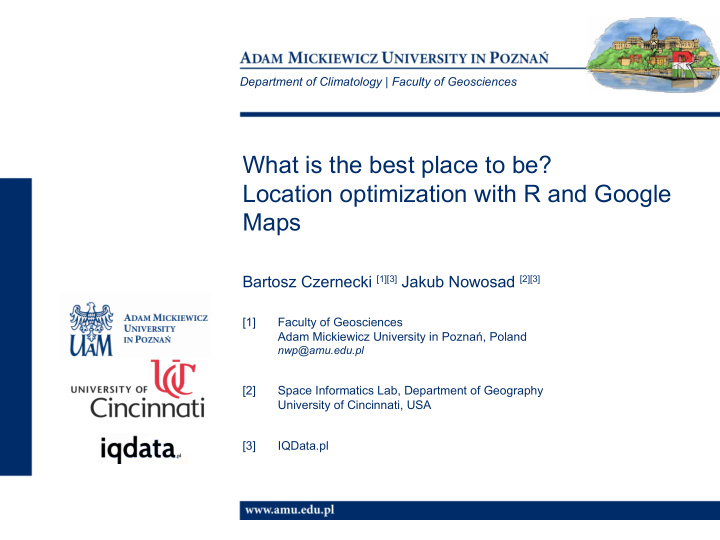



Department of Climatology | Faculty of Geosciences What is the best place to be? Location optimization with R and Google Maps Bartosz Czernecki [1][3] Jakub Nowosad [2][3] [1] Faculty of Geosciences Adam Mickiewicz University in Poznań, Poland nwp@amu.edu.pl [2] Space Informatics Lab, Department of Geography University of Cincinnati, USA [3] IQData.pl
Motivation → (boring) decision making The need to find a convient place to stay before every conference or business meeting in a new city ● Nearby the place of conference/business meeting ● With good public transportation facilities ● Affordable prices (or at least good quality/price ratio) ● Others: close to the downtown or any other attractive place to go in the evening, safe, etc..
How does it look in practice? Finding a location of conference/meeting
How does it look in practice? Searching for hotels: not too far away: ● a standard map with hotels (booking.com, google maps, etc..) giving euclidean distance to the downtown or some historical places ● Then filtering out ~70% (reason: price) ● Finding a set of hotels which gives us good distance/price ratio (+overall rating)
How does it look in practice? ~ Top 10 desinations that need to be checked (in terms of traveling time) → Hotel X1 → Walking 12 min., Public transport 10 min., Rating 6.6
How does it look in practice? ~ Top 10 desinations that need to be checked (in terms of traveling time) → Hotel X2 → Walking 25 min., Public transport 16-17 min., Rating 7.2
Time consuming process Ls DISTANCE FROM A HOTEL TO THE VENUE DOES NOT ALWAYS EQUAL TO TIME OF TRAVEL IS IT REALLY THE BEST AND FASTEST WAY OF PROCEEDING?
How to make it automatic or at least semi-automatic with and GIS? Create a regular mesh around the conference/meeting’s location: ● E.g. 1 x 1 km in UTM coordinates for 10-15 km in each direction (not too dense) ● Convert coordinates to lon-lat grid usable by the google services
How to make it automatic or at least semi-automatic with and GIS? Create a regular mesh around the conference/meeting’s location: ● E.g. 1 x 1 km in UTM coordinates for 10-15 km in each direction ● Convert coordinates to lon-lat grid usable by the google services ● Calculate distance and timefor each grid point with Google Maps Distance Matrix API
How to make it automatic or at least semi-automatic with and GIS? Create a regular mesh around the conference/meeting’s location: ● E.g. 1 x 1 km in UTM coordinates for 10-15 km in each direction ● Convert coordinates to lon-lat grid usable by the google services ● Calculate distance and timefor each grid point with Google Maps Distance Matrix API ● Repeat this step for walking, driving , bicycling, public transport
How to make it automatic or at least semi-automatic with and GIS? Taxi / Uber / etc… Public transportation Walking (2) Improving readability: Creating new layers with hotels’ location (over 300!) and transport barriers (e.g. rivers) → library: osmdata (3) Webscrapping of prices and hotel rates with RSelenium
How to make it automatic or at least semi-automatic with and GIS? (4) Interaction with leaflet clickable layers/features → strongly simplified version @rpubs: http://rpubs.com/bczernecki/388489 Taxi / Uber / etc… Public transportation Walking
How to make it automatic or at least semi-automatic with and GIS? → strongly simplified version @rpubs: http://rpubs.com/bczernecki/388489 Confirmation: Distance != Time
How to make it automatic or at least semi-automatic with and GIS? (5) Wrap up into (for non-nerdy people) and sum it up into table with sorted results (for data scientist)
Place → application elsewhere Further ideas: - Adding safety layer for districts - Advanced filtering and broader statistics for particular locations - Etc... Location intelligence (business) | Let’s meet halfway
Thank you for your atenton
Recommend
More recommend